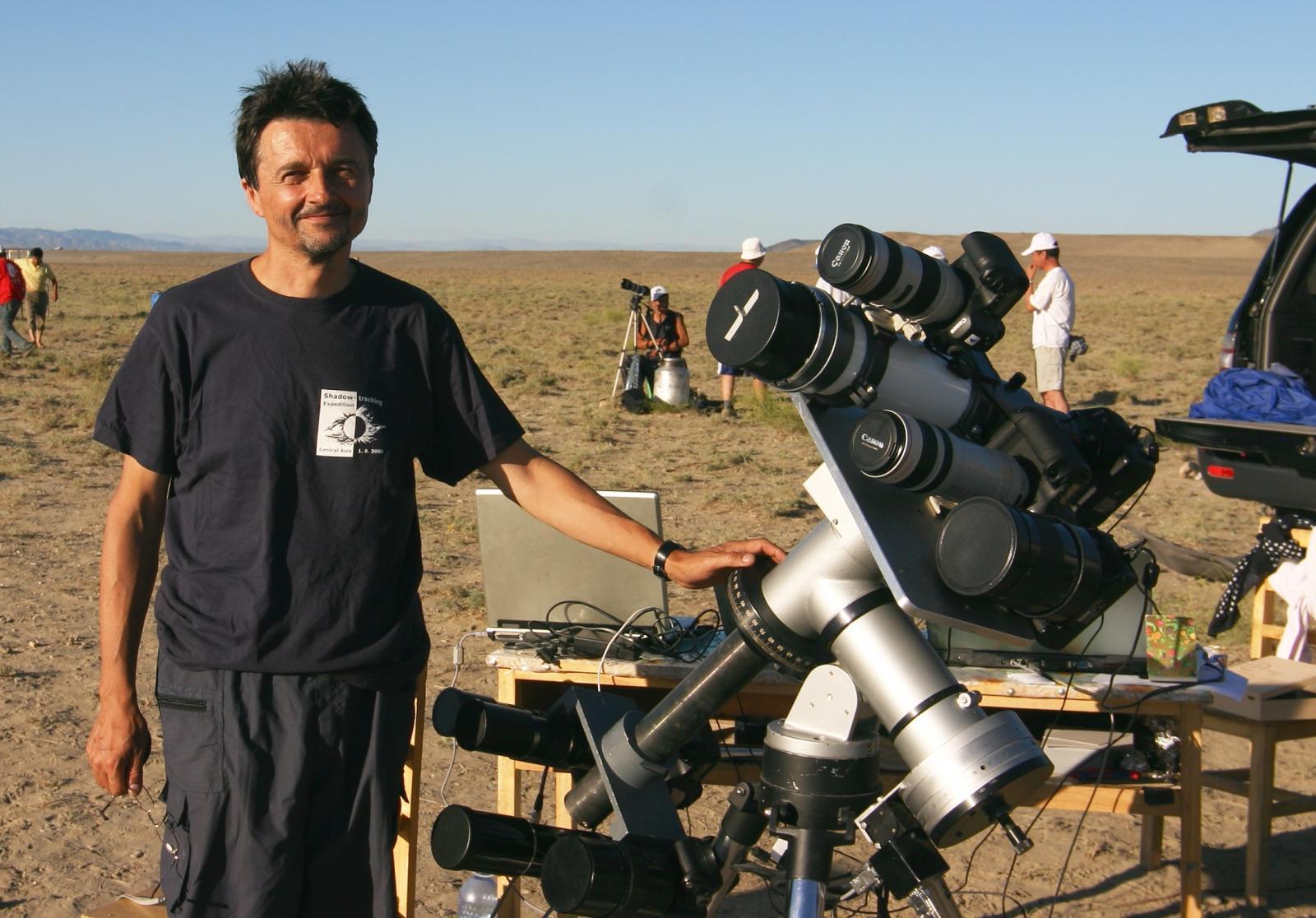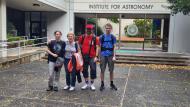Topic
A quarter of a century on the road to the Sun

“If you were to stand in any random place on Earth and stubbornly wait for a total solar eclipse, the average waiting time would be 360 years. So it’s not a good idea to look for these places randomly.” With these words, Miloslav Druckmüller from the Faculty of Mechanical Engineering at Brno University of Technology opened his lecture *A Quarter-Century Journey to the Sun*, which mapped 25 years of his expeditions in pursuit of total solar eclipses.
The most important moment always takes place during the brief period when the Moon covers the Sun, the world darkens, and birds fall silent. The moment when the solar corona becomes visible to the naked eye for a few brief seconds during a total solar eclipse is an awe-inspiring spectacle for the layperson. For members of the scientific expedition from BUT, it is the culmination of complex preparations, high expectations laced with uncertainty and stress, and often great disappointments. It all started in 1999, when Miloslav Druckmüller set out with colleagues, friends, and family to witness the eclipse in Hungary. “At that time, I brought back images taken on classic color film, which resembled reality only slightly. Since I’m a mathematician, I tried to create a more realistic image by combining multiple shots with different exposures,” recalls Miloslav Druckmüller. He produced a CD with commentary from these photographs, which began to spread globally and led to him meeting many interesting people. The most significant of these was a meeting with scientists from the University of Hawaii, which gave the Brno mathematician's work a scientific dimension and provided funding for meaningful expeditions.
In his time, Miloslav Druckmüller revealed the beauty of the Sun to laypeople and reignited interest in the scientific community in studying the star through total eclipses. The visualization of coronal structures visible in the visible spectrum remains one of the most challenging problems in astrophotography. Until recently, it was believed that photography could not capture the coronal structures observable by the human eye during an eclipse. However, over the past 25 years, Druckmüller succeeded in developing a system of computer programs based on new mathematical methods that allow the creation of solar corona images surpassing human vision and significantly outperforming current space probe capabilities in both the visible and infrared spectrum.

During the 2005 eclipse, he met Peter Aniol, co-owner of a German company producing top-tier astronomical equipment. For the next eclipse, Druckmüller got his hands on equipment he had only dreamed of. “In the Libyan desert, we had perfect gear from Peter, and it was operated by digital cameras controlled by a computer — thanks to my then-PhD student Jindra Nový, who wrote the camera control software. It was groundbreaking at the time and exceeded my boldest expectations,” recalls Druckmüller. The crucial turning point was meeting Shadia Habbal from the Institute for Astronomy at the University of Hawaii. “From the beginning, I asked Shadia a lot of silly questions, but over time, it turned out that a mathematician’s skeptical approach — always looking for mistakes — can sometimes be quite useful. Shadia mainly studies the radiation of heavy ions in the solar corona, which is an amazing diagnostic tool for plasma in the corona,” explains the mathematician from BUT.
The focus of the photographs gradually shifted to specific scientific objectives. “We aimed to make visible, for example, magnetic field lines, radiation from certain elements or their ions, and so on. About a year before each expedition, I design a precise program based on the intended outcomes of the data analysis. Astronomers and astrophysicists from the University of Hawaii primarily work with our data. Our team has already made several quite significant discoveries,” specifies Miloslav Druckmüller. Except for the “zero” mission in Hungary, which he genuinely enjoyed, all subsequent expeditions have been a great source of stress for him. “We were already responsible for the money invested in the project, and we didn’t want to make the slightest mistake,” explains Miloslav Druckmüller, why he eventually stopped participating in expeditions directly and started coordinating them remotely. Fortunately, he managed to “infect” his colleagues from the Institute of Mathematics — Jana Hoderová and Pavel Štarha. Jana discovered an adventurous spirit within herself, compelling her to head into dangerous locations under uncertain conditions — on horseback or a fishing boat — and to perform flawlessly under stress and tight schedules. And without Pavel Štarha as the author of the camera software and numerous technical improvements, today no expedition would be conceivable.

One of the most successful expeditions in history for the Brno team came in 2019, when Miloslav Druckmüller used 129 images from 41 different instruments to create an image of the solar corona over South America. A unique set of instruments, significantly improved again by Pavel Štarha, enabled the collection of the highest-quality data to date. This was followed by the dark COVID years, after which the team's efforts bore fruit again in 2023 during the eclipse in Australia. A unique setup weighing nearly 26 kilograms was designed and implemented once again by the indispensable Pavel Štarha. “We acquired new filters that, unlike the old ones, do not require a thermostat and remain stable across a wide temperature range. New optics helped, and most importantly, new CMOS cameras allowed us to capture dozens of images per second with ten times better resolution than the original ones. The images of the white solar corona were globally unique, as were the spectral line images of iron and argon ions. For the first time, we managed to observe nine-times-ionized argon, and it's worth noting that we’ve been observing iron and nickel ions since 2008. Observing these ions essentially provides a method to indirectly measure the temperature of the solar corona — something that otherwise cannot be measured,” emphasizes Miloslav Druckmüller.

The most recent eclipse, in April 2024 in North America, brought further technical improvements and the best equipment to date. The main group, including Miloslav Druckmüller and Pavel Štarha, had an observation site in Mexico, while Shadia Habbal, Jana Hoderová, Petr Štarha, and three mechatronics students from the Faculty of Mechanical Engineering went to Arkansas. The eclipse occurred at the peak of the 11-year solar activity cycle, and the entire observation program was tailored to complete a data set capturing the full solar activity cycle. “Thanks to Shadia Habbal’s efforts, we managed to secure a NASA airplane capable of flying up to 24 kilometers above the Earth as a mobile observation site. We have it promised for the next three eclipses,” says Miloslav Druckmüller with anticipation.
Optical fibres will help peek into the deepest parts of the brain. A doctoral student from FME is involved in the research
Doctoral students in engineering study the behaviour of the circulatory system. Neural networks also help them
The king of cycling Jakub Mašek got an internship at the European space agency
Auxetic material behaves differently than you would expect, says student Tomáš Vítek
Smart dispatching system for virtual power plants co-developed by experts from FME BUT

